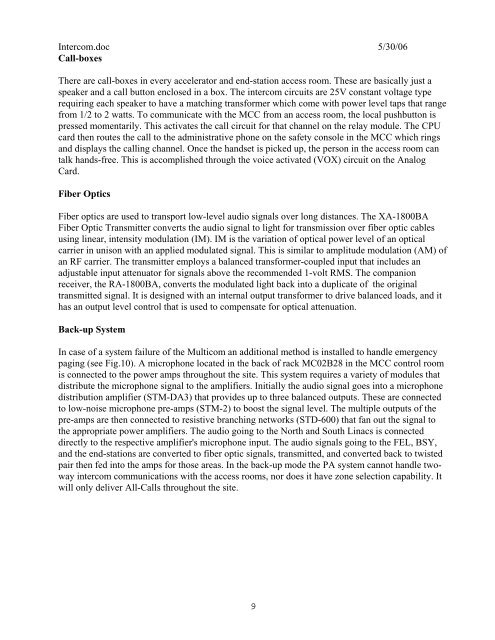DESCRIPTION OF PA / INTERCOM SYSTEM - Jefferson Lab
DESCRIPTION OF PA / INTERCOM SYSTEM - Jefferson Lab
DESCRIPTION OF PA / INTERCOM SYSTEM - Jefferson Lab
You also want an ePaper? Increase the reach of your titles
YUMPU automatically turns print PDFs into web optimized ePapers that Google loves.
Intercom.doc 5/30/06<br />
Call-boxes<br />
There are call-boxes in every accelerator and end-station access room. These are basically just a<br />
speaker and a call button enclosed in a box. The intercom circuits are 25V constant voltage type<br />
requiring each speaker to have a matching transformer which come with power level taps that range<br />
from 1/2 to 2 watts. To communicate with the MCC from an access room, the local pushbutton is<br />
pressed momentarily. This activates the call circuit for that channel on the relay module. The CPU<br />
card then routes the call to the administrative phone on the safety console in the MCC which rings<br />
and displays the calling channel. Once the handset is picked up, the person in the access room can<br />
talk hands-free. This is accomplished through the voice activated (VOX) circuit on the Analog<br />
Card.<br />
Fiber Optics<br />
Fiber optics are used to transport low-level audio signals over long distances. The XA-1800BA<br />
Fiber Optic Transmitter converts the audio signal to light for transmission over fiber optic cables<br />
using linear, intensity modulation (IM). IM is the variation of optical power level of an optical<br />
carrier in unison with an applied modulated signal. This is similar to amplitude modulation (AM) of<br />
an RF carrier. The transmitter employs a balanced transformer-coupled input that includes an<br />
adjustable input attenuator for signals above the recommended 1-volt RMS. The companion<br />
receiver, the RA-1800BA, converts the modulated light back into a duplicate of the original<br />
transmitted signal. It is designed with an internal output transformer to drive balanced loads, and it<br />
has an output level control that is used to compensate for optical attenuation.<br />
Back-up System<br />
In case of a system failure of the Multicom an additional method is installed to handle emergency<br />
paging (see Fig.10). A microphone located in the back of rack MC02B28 in the MCC control room<br />
is connected to the power amps throughout the site. This system requires a variety of modules that<br />
distribute the microphone signal to the amplifiers. Initially the audio signal goes into a microphone<br />
distribution amplifier (STM-DA3) that provides up to three balanced outputs. These are connected<br />
to low-noise microphone pre-amps (STM-2) to boost the signal level. The multiple outputs of the<br />
pre-amps are then connected to resistive branching networks (STD-600) that fan out the signal to<br />
the appropriate power amplifiers. The audio going to the North and South Linacs is connected<br />
directly to the respective amplifier's microphone input. The audio signals going to the FEL, BSY,<br />
and the end-stations are converted to fiber optic signals, transmitted, and converted back to twisted<br />
pair then fed into the amps for those areas. In the back-up mode the <strong>PA</strong> system cannot handle twoway<br />
intercom communications with the access rooms, nor does it have zone selection capability. It<br />
will only deliver All-Calls throughout the site.<br />
9
















